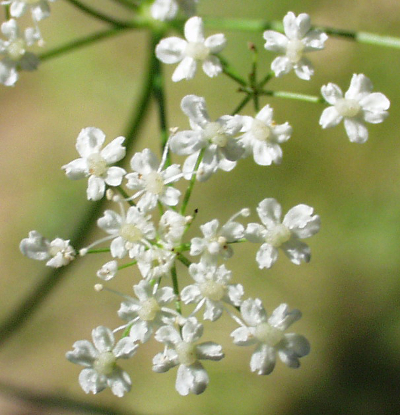Carum |

The marginal flowers of the caraway are not or only slightly enlarged

The caraway can be recognized by the typical basal leaves
The English name "caraway" for Carum
carvi is probably derived from al-karawya,
an Arabic term, which in turn has its roots in Latin Carum. Linnaeus
took over in 1753 the generic name from Caspar Bauhin, who
listed the caraway as Carum pratense and Carvi
officinarum. Linnaeus converted "carvi" into a specific
epithet.
The genus includes about 30 species and is native to Eurasia, North America and North Africa. It consists of biennial to short-lived, glabrous herbs with spindle-shaped, bulbous or elongated taproot. The stems are decumbent to erect, sometimes surrounded at the base by a membranous sheath and usually branched at the top.
The basal leaves are stalked and 2- to 4-fold pinnate, whereas the leaflets arranged decussate at the rachis, and the leaflets are linear to lanceolate. The stalked stem leaves are alternate and gradually reduced upward in size. The petiole at base is narrowly sheathing the stem. The upper stem leaves are 1- to 2-fold pinnate with linear-filiform leaflets.
The inflorescence is a terminal double umbel. Bracts of the umbel, the so-called involucre, missing or are similar to the upper stem leaves. The umbel with 3 to 28 rays splits into umbellules which carry white, yellowish, rarely violet or pink flowers. The few linear bracts, which can also be absent, form the involucel. Calyx teeth are missing or very small, rarely clearly visible and narrowly triangular. The flowers are small and hermaphrodite, their petals are curved inward at the top.
After insect pollination the inferior ovary forms oblong-ovate, laterally slightly flattened fruits with 10 very prominent ribs. They are composed of 2 mericarps with each 5 ribs. At maturity, the fruits turn dark brown, the ribs yellowish.
| Floral formula: |
| * K5 C5 A5 G(2) inferior |
Black caraway
From a completely different family, namely the Ranunculaceae, comes the black caraway (Nigella sativa). The genus Nigella's many amateur gardeners familiar: as "love-in-a-mist" (Nigella damascena) it adorns many cottage gardens. We all know the black caraway from the Turkish cuisine: It is scattered to flatbreads, next to sesame, which has a very similar flavor.
Meaning of the species name
- carvi: Mediaeval Latin carvi = Caraway (Derived from Dioscorides' Karon, which is similar to Pliny's Careum. Probably not the real caraway)
Interesting notes
-
Carum verticillatum, the whorled caraway, is extinct in Germany. It populated marshy wetlands.
-
The gladich or horse caraway (Laser trilobum) is an in Germany specially protected plant, that smells of caraway.